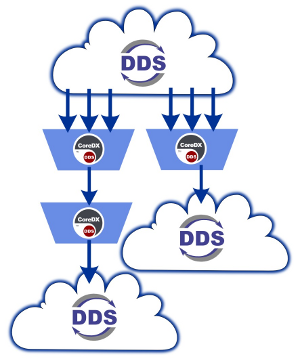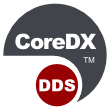CoreDX DDS Multiplexor
Complex Deployments made Easy
Overview
The CoreDX DDS Multiplexor software is designed to provide system developers with maximum control over DDS publications and subscriptions. The CoreDX DDS Multiplexor includes robust facilities to aggregate, transform, and bridge DDS data.

The power of the CoreDX Multiplexor comes from its flexibility. With the ability to transform any DDS Topic, based on dynamically discovered type information, the CoreDX Multiplexor is easily deployed into an existing DDS infrastructure without requiring access to application source code. This eases deployment and maintenance.
The CoreDX DDS Multiplexor is designed to use a minimal amount of system resources. This largely due to the fact that it is built on the leading small-footprint CoreDX DDS middleware. The CoreDX DDS Multiplexor is also compliant with the Real-Time Publish-Subscribe wire protocol, making it interoperable with any other compliant DDS middleware.
Deployment Scenarios
There are many ways to use the CoreDX DDS Multiplexor to solve integration challenges.
The CoreDX DDS Multiplexor can be used to bridge between two DDS Domains. The CoreDX DDS Multiplexor can selectively forward topic data and transform topic QoS policies. This configuration is particularly useful when connecting and exchanging data between systems with different DDS deployment strategies.
A common DDS deployment challenge is communicating over multiple network segments. Not all routers are capable of forwarding multicast data, and in some deployment scenarios, intermediate routers may not be accessible or controllable. The CoreDX DDS Multiplexor can be used at each 'local' network to bridge the network segments in between.
The CoreDX DDS Multiplexor can be used to aggregate multiple data sources in to one.
The CoreDX DDS Multiplexor can be used between realtime system components and non-realtime components, insulating the different requirements between the domains.
Configuration
The CoreDX DDS Multiplexor allows the user to configure multiple Ports. Each port provides a mechanism to manipulate multiple DDS topics, transforming QoS policies, changing Domain ID, changing topic name, and changing transports. Each port reads the specified topics, applies the specified QoS policies, aggregates the data, and forwards the data onto the other
end of the port.
The network designer can specify all QoS policies, specify the Domain ID, specify transport specific configuration, and specify topic names on both the incoming and outgoing port. Connecting multiple Multiplexors together creates a dynamic mechanism to bridge DDS data across complex network segments—not possible using the standard multicast protocols of RTPS.
All configuration is handled by XML configuration file(s), which can be generated manually or using automated tools.
The CoreDX DDS Multiplexor includes CoreDX DDS Dynamic Type technology. The Dynamic Type technology enables discovery of data type information at runtime, and makes deploying a multiplexor network very easy. The Multiplexor can adapt to changing data types at run-time with no additional configuration required. The CoreDX DDS Multiplexor can support multiple ports simultaneously, and can run on the same machine with other Multiplexors.







